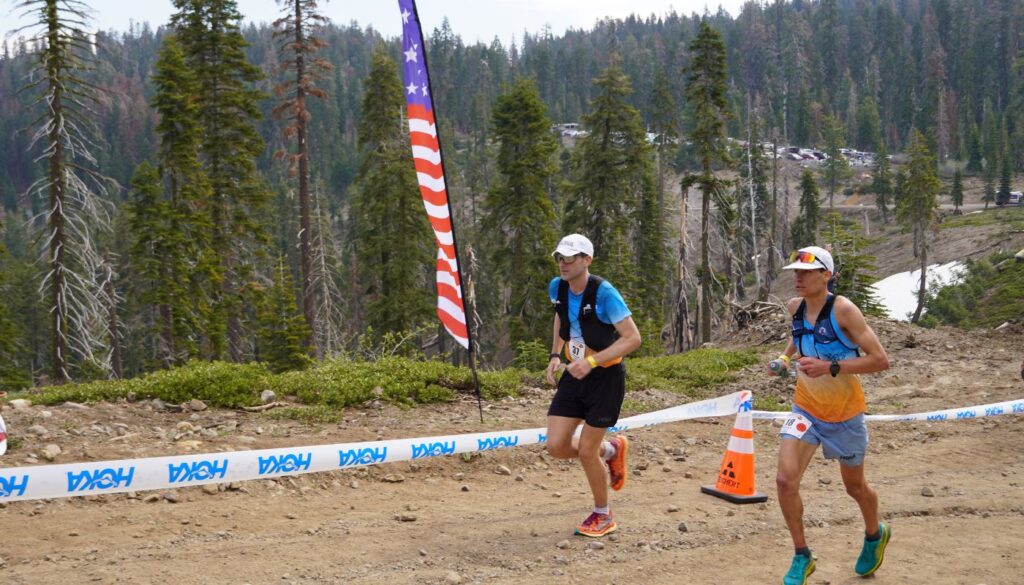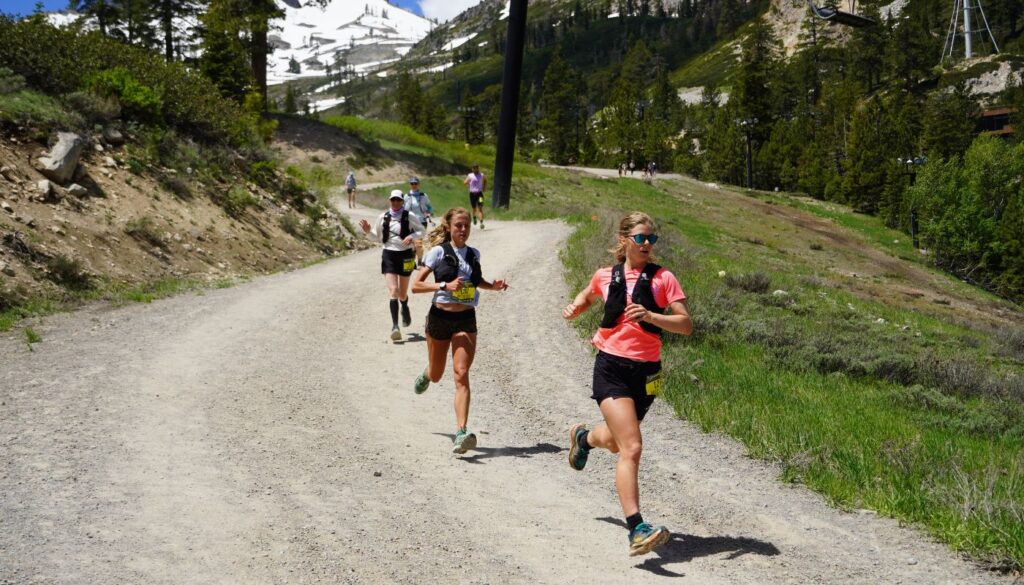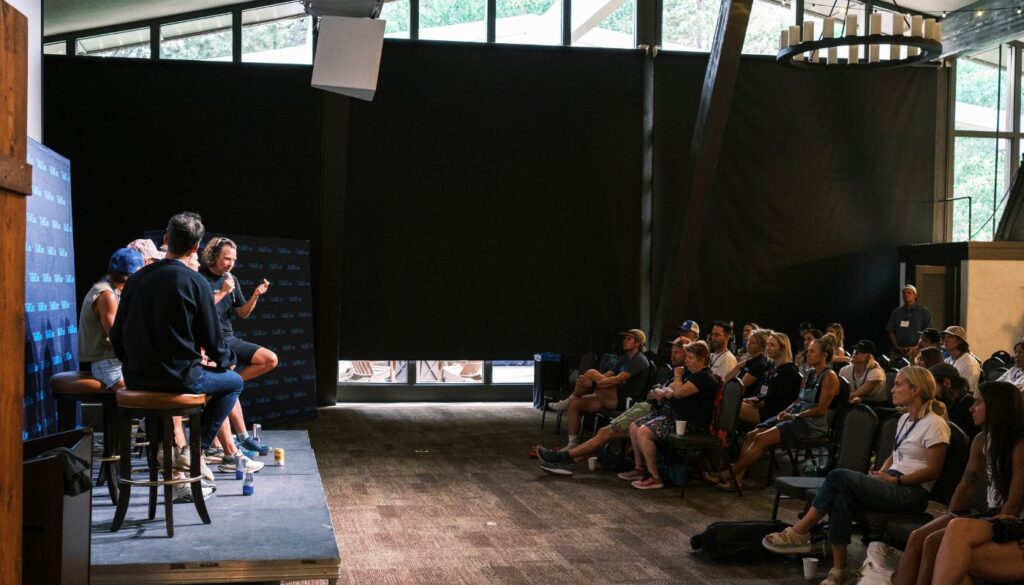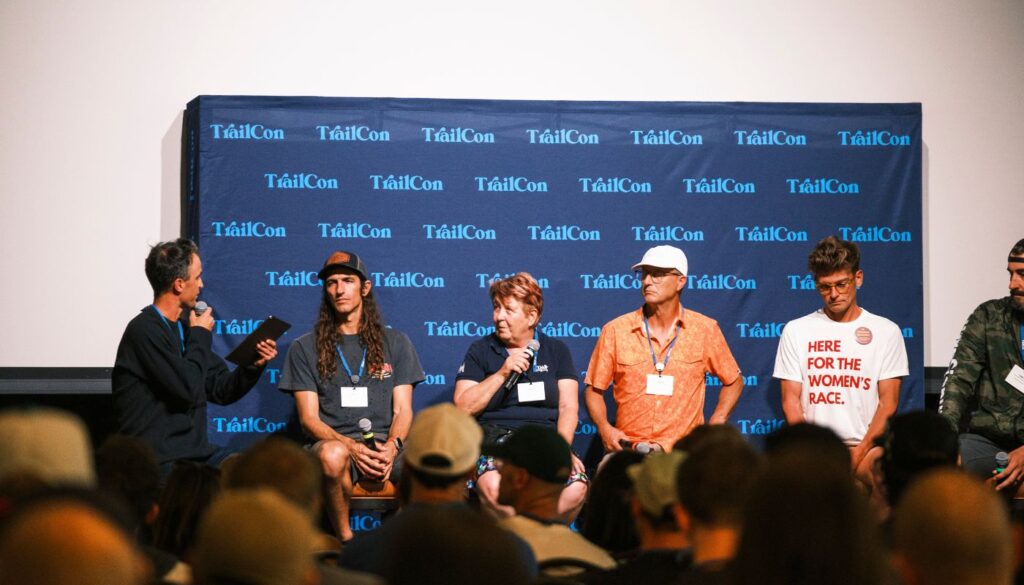Trail running industry veteran Brian Metzler shares his perspective about the biggest week in trail running.
If you’re a trail runner — and also a fan of trail running who cares about where the sport is headed — and you’re not already planning to be there, then you should highly consider making last-minute plans to drive, fly, or take a train so you can find your way to the base of Palisades Tahoe ski area to experience it all in person.
But what’s happening June 20-29 is only partially about the great trail racing events on tap.
At the ski resort base village and on the dirt trails of the summer slopes, the past, present, and future of the U.S. trail running will be on display and, hopefully, where numerous seeds will be sown for how it will evolve in the next decade or more. I am not exaggerating when I say the 10-day span — starting with the Broken Arrow Skyrace and continuing through the TrailCon symposium, and finally the Western States 100 — will combine to be the biggest and most prominent moment in the history of American trail running. (If you can’t make it, download the app or tune in to the livestream of select Broken Arrow races on June 20 and Western States on June 28-29.)
Yes, there will be epic races from 5K to 100 miles, but what’s more important is that the week will feature the most comprehensive representation of the U.S. trail running community ever gathered in one place. It will be a who’s who of many of the world’s top trail runners and dozens of pioneers and legends of the sport. There will be shakeout runs, morning coffee gatherings, and activations from the top gear and accessory brands like Salomon, Nike, Hoka, On, and Vibram.
But most importantly, there will be a wide range of inspired thought leaders, industry representatives, media personalities, athletes, and age-group trail runners embedded in the culture of the sport who will be talking about how to shape the future.

While the back-to-back combination of Broken Arrow Skyrace and Western States has been a thing for a few years, never before has so much trail running talent been concentrated in the U.S. in such a close proximity. In what is the perfect storm of top athletes and high-stakes events that merges mountain running and ultrarunning, Broken Arrow Skyrace and Western States 100 will offer up ridiculously competitive races in every distance and discipline of trail running.
Obviously, the Western States 100 speaks for itself, and it has since 1974 when Gordy Ainsleigh completed the 100-mile route of the Tevis Cup horse race sans horse. While the first official race in 1978 was by no means the original ultra-distance race, it did give rise to the 100-mile distance as the marquee event that helped the sport gain notoriety. It’s always been the most competitive ultra in the U.S. and it’s continued to hold its own amid the globalization of the sport.

But the rise and evolution of Broken Arrow Sky Race has become equally as important in this early summer celebration of trail running. Founders Brendan Madigan, Ethan Veneklasen, and Geoff Quine can never get enough credit for building and positioning this three-day festival of trail running. But what’s especially important is not only what they built — an array of races over numerous disciplines — but how they built it, namely with inclusivity and accessibility for anyone and everyone who wants to participate.
While the continued advancement of ultrarunning has been astounding and benefitted all aspects of trail running — including the gear, training, and nutrition breakthroughs that have mostly come through the ultra side of the sport — the discipline of shorter, faster mountain running, in my opinion, has too often has had to play second fiddle. For the sport to continue to grow, we must make shorter-distance mountain running as intriguing as ultrarunning has been. Not everyone will (or can) aspire to be an obsessed 100-mile lifer, nor is it best for developing a broader community connected to the sport.
Fortunately, that’s slowly changing for the better, and there’s no better indication of that than how the smorgasbord of Broken Arrow races (and the timing just before Western States) gives equal prominence to mountain runners and “sub-ultra” events. And the beauty of the Ascent race, a 3-mile, 3,000-foot uphill grind to the 8,855-foot summit of Washeshu Peak, is that it’s a bit of an equalizer in which runners who typically run shorter and faster will go head-to-head with ultra-distance specialists.
In the men’s race, American mountain running legend and two-time world champion Joe Gray will go head-to-head with Golden Trail World Series stalwart Patrick Kipngeno of Kenya, multi-talented U.S. runner Christian Allen, and all-time trail running GOAT Kilian Jornet, who is famously doubling back in Western States for the first time since he won it in 2011.
The women’s side figures to be a battle of the past two champions, Kenya’s Joyce Muthoni Njeru and American Anna Gibson, and a cast of other great U.S. mountain runners including 2022 world champion Allie McLaughlin, Rachel Tomajczyk, Janelle Lincks, Kasie Enman, and Mercedes Siegle-Gaither, who have all mixed it up in sub-ultra and ultra racing.

That race is not only a World Mountain Running Association World Cup points race, but it’s also an official qualifier for the U.S. team that will compete at the 2025 World Mountain and Trail Running Championships September 25-28 in Canfranc-Pirineos, Spain. After struggling to gain footing in its Covid-delayed infancy, those combined world championships (which have been backed in part by World Athletics, the global governing body of all disciplines of running) have become a marquee attraction on the global race calendar, so making the U.S. team is a huge deal. And those world championships will become even more prominent as a step to helping trail running make it into the 2032 Olympics in Brisbane, Australia.
Broken Arrow’s 46K race is also a Team USA qualifier, while the 23K race is also a World Cup points race and part of the highly competitive Golden Trails World Series circuit. Those races will include several more high-profile international athletes — among them Switzerland’s Rémi Bonnet, Morocco’s Elhousine Elazzaoui, Romania’s Monica Mădălina Florea — and dozens of elite-level Americans like Eli Hemming, Grayson Murphy, Dani Moreno, and Mason Coppi.
Throw in lower-profile 11K and 18K races that are accessible to a all levels of runners, plus the Iron Face Challenge, which includes technical uphill and downhill running, plus the intricate tests of a via ferrata section, and you have all the makings of non-stop, high-energy racing that will stir excitement a week before the infinitely compelling full-day burn of Western States 100 race narratives and front-of-the-pack racing action.
But the upcoming cavalcade of trail running curiosities is much more than just about running fast on the trails.
“We’ve made no secret, we put Broken Arrow on the weekend before Western States to cater to pacers and crew and family members, so they could come out a week early and, and have a good time and challenge themselves on the mountains,” Madigan said. “With TrailCon, we feel like we’ve created a bridge event to two of the more important races in the U.S., if not the world. We feel we’ve helped create the late spring capital of the trail running world.”
For years, the American trail running community has clung tightly to its grassroots origins, but ultimately it didn’t change much at all. While the dirtbag sensibilities the sport professed had its own grunge coolness to those immersed in it, just as with society in general, it was either inadvertently unaware or completely oblivious about how to grow the sport with a more inclusive welcome mat. Only recently have we, as a sport and a community, opened our arms to a wider worldview and intentionally started attracting more women, adaptive athletes, LGBTQIA+ individuals, and runners from diverse racial backgrounds.
And that’s why an integral part of the week will certainly be the second edition of TrailCon, a two-day forum of panel discussions and hot topic sessions spearheaded by Madigan, elite athlete/media personality Dylan Bowman, and event industry veteran and passionate age-group runner Doug Emslie. After a handful of brief but meaningful discussion sessions and a happy hour on a singular day last year, TrailCon has been expanded to two days with perhaps the widest range of thought leaders and topics that the sport has ever approached en masse.

TrailCon panels will discuss the state of the trail running events market, the intersection of trail running and the creator/influencer economy, how to expand the trail running community more inclusively, several aspects of the continued commercialization and professionalization of trail running, the future of the Western States 100, and sustainability, stewardship, and climate concerns.
There will be other topics discussed too. What does responsible growth look like? How should brands best be involved in the sport? How can global and domestic championship series best benefit elite athletes and the sport? How can commercialization best serve the sport without overrunning it? And even how can we agree to disagree without going down the rabbit hole in reactionary social media comment sections?
“That’s exactly what we’re hoping to do with TrailCon,” Bowman said. “We want to have a place where we can get together and talk about things so it’s not left to fragmented gossip at every race where nothing really happens or there’s no progress made and there’s no path towards some like kind of mutual understanding of where things are going on and how different things can fit in.”
Ultimately all of those topics point to where we’re going as a sport, as a recreational pastime, as an industry, and as a community. It all comes as a crucial time in the sport — especially as a new generation of passionate recreational trail runners, event directors, media personalities, and young professional athletes come of age — and in the world, where polarizing ideologies dramatically impact trail runners as citizens of the world.
This is the biggest moment in American trail running. What comes out of it — the race results, the connections, the discussions, and the interactive community vibe — will certainly help shape what comes next.
